Yanqi Zhou
Scalable Multi-Domain Adaptation of Language Models using Modular Experts
Oct 14, 2024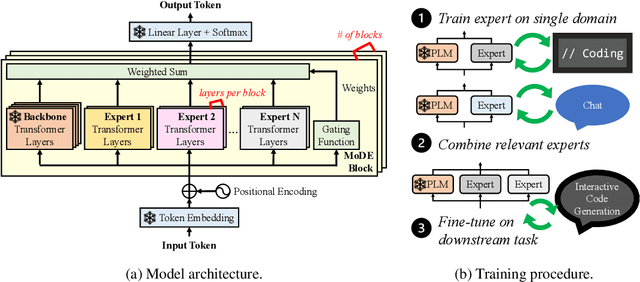
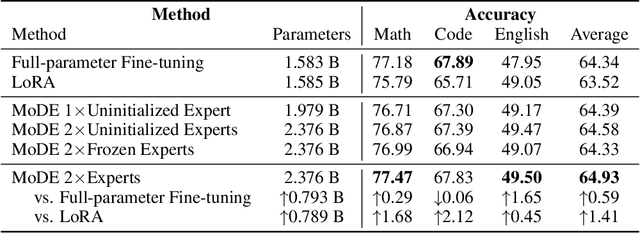

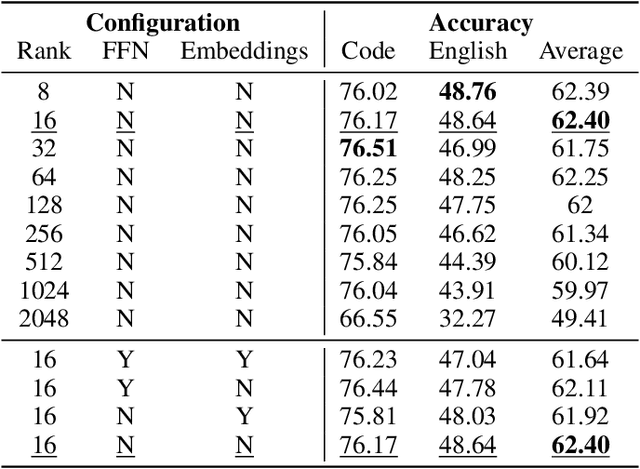
Abstract:Domain-specific adaptation is critical to maximizing the performance of pre-trained language models (PLMs) on one or multiple targeted tasks, especially under resource-constrained use cases, such as edge devices. However, existing methods often struggle to balance domain-specific performance, retention of general knowledge, and efficiency for training and inference. To address these challenges, we propose Modular Domain Experts (MoDE). MoDE is a mixture-of-experts architecture that augments a general PLMs with modular, domain-specialized experts. These experts are trained independently and composed together via a lightweight training process. In contrast to standard low-rank adaptation methods, each MoDE expert consists of several transformer layers which scale better with more training examples and larger parameter counts. Our evaluation demonstrates that MoDE achieves comparable target performances to full parameter fine-tuning while achieving 1.65% better retention performance. Moreover, MoDE's architecture enables flexible sharding configurations and improves training speeds by up to 38% over state-of-the-art distributed training configurations.
SPLAT: A framework for optimised GPU code-generation for SParse reguLar ATtention
Jul 23, 2024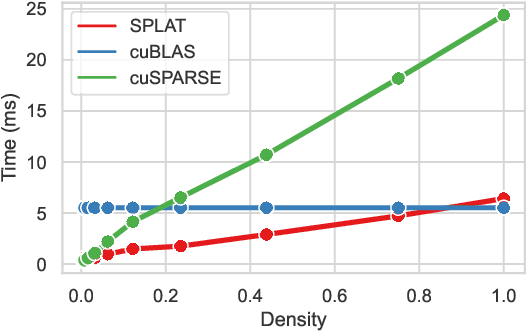
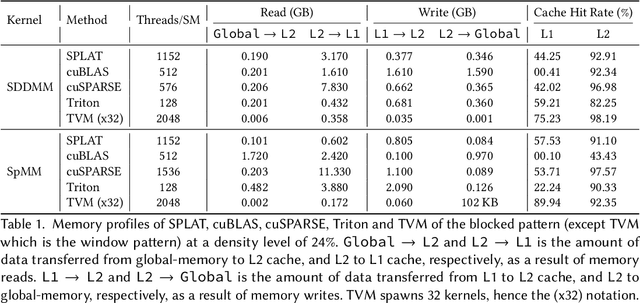

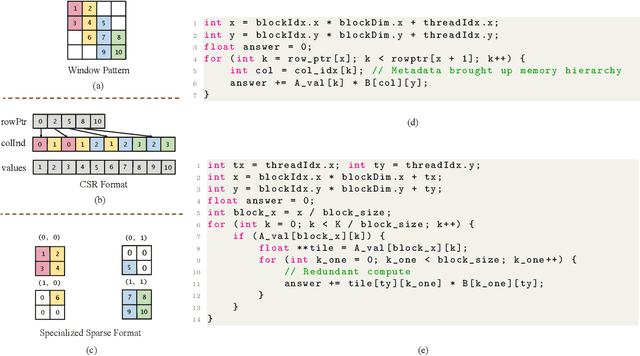
Abstract:Multi-head-self-attention (MHSA) mechanisms achieve state-of-the-art (SOTA) performance across natural language processing and vision tasks. However, their quadratic dependence on sequence lengths has bottlenecked inference speeds. To circumvent this bottleneck, researchers have proposed various sparse-MHSA models, where a subset of full attention is computed. Despite their promise, current sparse libraries and compilers do not support high-performance implementations for diverse sparse-MHSA patterns due to the underlying sparse formats they operate on. These formats, which are typically designed for high-performance & scientific computing applications, are either curated for extreme amounts of random sparsity (<1% non-zero values), or specific sparsity patterns. However, the sparsity patterns in sparse-MHSA are moderately sparse (10-50% non-zero values) and varied, resulting in existing sparse-formats trading off generality for performance. We bridge this gap, achieving both generality and performance, by proposing a novel sparse format: affine-compressed-sparse-row (ACSR) and supporting code-generation scheme, SPLAT, that generates high-performance implementations for diverse sparse-MHSA patterns on GPUs. Core to our proposed format and code generation algorithm is the observation that common sparse-MHSA patterns have uniquely regular geometric properties. These properties, which can be analyzed just-in-time, expose novel optimizations and tiling strategies that SPLAT exploits to generate high-performance implementations for diverse patterns. To demonstrate SPLAT's efficacy, we use it to generate code for various sparse-MHSA models, achieving geomean speedups of 2.05x and 4.05x over hand-written kernels written in triton and TVM respectively on A100 GPUs. Moreover, its interfaces are intuitive and easy to use with existing implementations of MHSA in JAX.
FLuRKA: Fast fused Low-Rank & Kernel Attention
Jun 27, 2023



Abstract:Many efficient approximate self-attention techniques have become prevalent since the inception of the transformer architecture. Two popular classes of these techniques are low-rank and kernel methods. Each of these methods has its own strengths. We observe these strengths synergistically complement each other and exploit these synergies to fuse low-rank and kernel methods, producing a new class of transformers: FLuRKA (Fast Low-Rank and Kernel Attention). FLuRKA provide sizable performance gains over these approximate techniques and are of high quality. We theoretically and empirically evaluate both the runtime performance and quality of FLuRKA. Our runtime analysis posits a variety of parameter configurations where FLuRKA exhibit speedups and our accuracy analysis bounds the error of FLuRKA with respect to full-attention. We instantiate three FLuRKA variants which experience empirical speedups of up to 3.3x and 1.7x over low-rank and kernel methods respectively. This translates to speedups of up to 30x over models with full-attention. With respect to model quality, FLuRKA can match the accuracy of low-rank and kernel methods on GLUE after pre-training on wiki-text 103. When pre-training on a fixed time budget, FLuRKA yield better perplexity scores than models with full-attention.
Brainformers: Trading Simplicity for Efficiency
May 29, 2023



Abstract:Transformers are central to recent successes in natural language processing and computer vision. Transformers have a mostly uniform backbone where layers alternate between feed-forward and self-attention in order to build a deep network. Here we investigate this design choice and find that more complex blocks that have different permutations of layer primitives can be more efficient. Using this insight, we develop a complex block, named Brainformer, that consists of a diverse sets of layers such as sparsely gated feed-forward layers, dense feed-forward layers, attention layers, and various forms of layer normalization and activation functions. Brainformer consistently outperforms the state-of-the-art dense and sparse Transformers, in terms of both quality and efficiency. A Brainformer model with 8 billion activated parameters per token demonstrates 2x faster training convergence and 5x faster step time compared to its GLaM counterpart. In downstream task evaluation, Brainformer also demonstrates a 3% higher SuperGLUE score with fine-tuning compared to GLaM with a similar number of activated parameters. Finally, Brainformer largely outperforms a Primer dense model derived with NAS with similar computation per token on fewshot evaluations.
Flan-MoE: Scaling Instruction-Finetuned Language Models with Sparse Mixture of Experts
May 24, 2023Abstract:The explosive growth of language models and their applications have led to an increased demand for efficient and scalable methods. In this paper, we introduce Flan-MoE, a set of Instruction-Finetuned Sparse Mixture-of-Expert (MoE) models. We show that naively finetuning MoE models on a task-specific dataset (in other words, no instruction-finetuning) often yield worse performance compared to dense models of the same computational complexity. However, our Flan-MoE outperforms dense models under multiple experiment settings: instruction-finetuning only and instruction-finetuning followed by task-specific finetuning. This shows that instruction-finetuning is an essential stage for MoE models. Specifically, our largest model, Flan-MoE-32B, surpasses the performance of Flan-PaLM-62B on four benchmarks, while utilizing only one-third of the FLOPs. The success of Flan-MoE encourages rethinking the design of large-scale, high-performance language models, under the setting of task-agnostic learning.
GiPH: Generalizable Placement Learning for Adaptive Heterogeneous Computing
May 23, 2023Abstract:Careful placement of a computational application within a target device cluster is critical for achieving low application completion time. The problem is challenging due to its NP-hardness and combinatorial nature. In recent years, learning-based approaches have been proposed to learn a placement policy that can be applied to unseen applications, motivated by the problem of placing a neural network across cloud servers. These approaches, however, generally assume the device cluster is fixed, which is not the case in mobile or edge computing settings, where heterogeneous devices move in and out of range for a particular application. We propose a new learning approach called GiPH, which learns policies that generalize to dynamic device clusters via 1) a novel graph representation gpNet that efficiently encodes the information needed for choosing a good placement, and 2) a scalable graph neural network (GNN) that learns a summary of the gpNet information. GiPH turns the placement problem into that of finding a sequence of placement improvements, learning a policy for selecting this sequence that scales to problems of arbitrary size. We evaluate GiPH with a wide range of task graphs and device clusters and show that our learned policy rapidly find good placements for new problem instances. GiPH finds placements with up to 30.5% lower completion times, searching up to 3X faster than other search-based placement policies.
Learning Large Graph Property Prediction via Graph Segment Training
May 21, 2023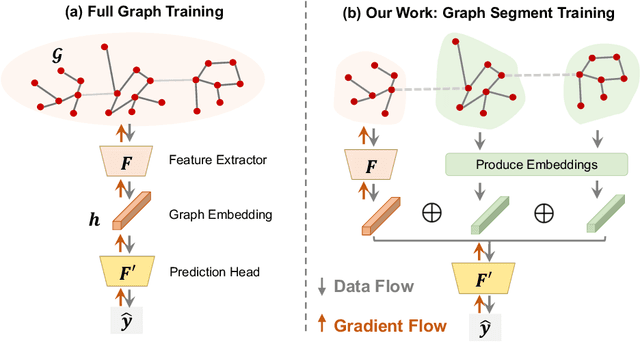



Abstract:Learning to predict properties of large graphs is challenging because each prediction requires the knowledge of an entire graph, while the amount of memory available during training is bounded. Here we propose Graph Segment Training (GST), a general framework that utilizes a divide-and-conquer approach to allow learning large graph property prediction with a constant memory footprint. GST first divides a large graph into segments and then backpropagates through only a few segments sampled per training iteration. We refine the GST paradigm by introducing a historical embedding table to efficiently obtain embeddings for segments not sampled for backpropagation. To mitigate the staleness of historical embeddings, we design two novel techniques. First, we finetune the prediction head to fix the input distribution shift. Second, we introduce Stale Embedding Dropout to drop some stale embeddings during training to reduce bias. We evaluate our complete method GST-EFD (with all the techniques together) on two large graph property prediction benchmarks: MalNet and TpuGraphs. Our experiments show that GST-EFD is both memory-efficient and fast, while offering a slight boost on test accuracy over a typical full graph training regime.
Lifelong Language Pretraining with Distribution-Specialized Experts
May 20, 2023Abstract:Pretraining on a large-scale corpus has become a standard method to build general language models (LMs). Adapting a model to new data distributions targeting different downstream tasks poses significant challenges. Naive fine-tuning may incur catastrophic forgetting when the over-parameterized LMs overfit the new data but fail to preserve the pretrained features. Lifelong learning (LLL) aims to enable information systems to learn from a continuous data stream across time. However, most prior work modifies the training recipe assuming a static fixed network architecture. We find that additional model capacity and proper regularization are key elements to achieving strong LLL performance. Thus, we propose Lifelong-MoE, an extensible MoE (Mixture-of-Experts) architecture that dynamically adds model capacity via adding experts with regularized pretraining. Our results show that by only introducing a limited number of extra experts while keeping the computation cost constant, our model can steadily adapt to data distribution shifts while preserving the previous knowledge. Compared to existing lifelong learning approaches, Lifelong-MoE achieves better few-shot performance on 19 downstream NLP tasks.
Conditional Adapters: Parameter-efficient Transfer Learning with Fast Inference
Apr 11, 2023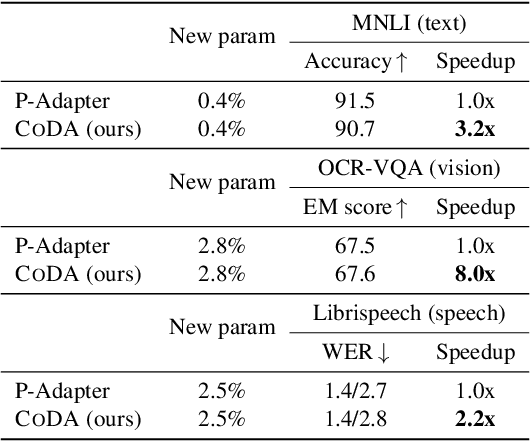
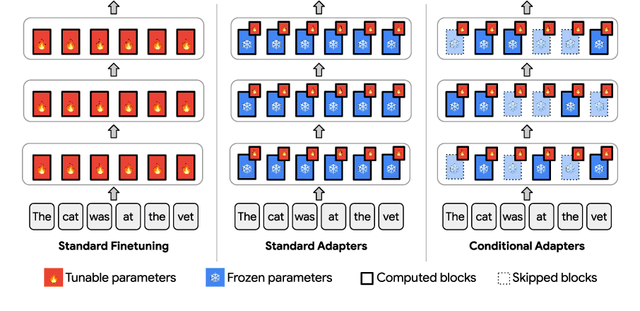
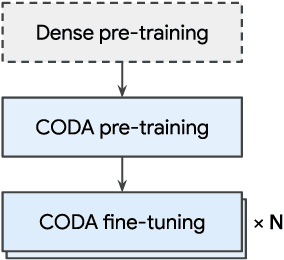

Abstract:We propose Conditional Adapter (CoDA), a parameter-efficient transfer learning method that also improves inference efficiency. CoDA generalizes beyond standard adapter approaches to enable a new way of balancing speed and accuracy using conditional computation. Starting with an existing dense pretrained model, CoDA adds sparse activation together with a small number of new parameters and a light-weight training phase. Our experiments demonstrate that the CoDA approach provides an unexpectedly efficient way to transfer knowledge. Across a variety of language, vision, and speech tasks, CoDA achieves a 2x to 8x inference speed-up compared to the state-of-the-art Adapter approach with moderate to no accuracy loss and the same parameter efficiency.
Toward Edge-Efficient Dense Predictions with Synergistic Multi-Task Neural Architecture Search
Oct 04, 2022



Abstract:In this work, we propose a novel and scalable solution to address the challenges of developing efficient dense predictions on edge platforms. Our first key insight is that MultiTask Learning (MTL) and hardware-aware Neural Architecture Search (NAS) can work in synergy to greatly benefit on-device Dense Predictions (DP). Empirical results reveal that the joint learning of the two paradigms is surprisingly effective at improving DP accuracy, achieving superior performance over both the transfer learning of single-task NAS and prior state-of-the-art approaches in MTL, all with just 1/10th of the computation. To the best of our knowledge, our framework, named EDNAS, is the first to successfully leverage the synergistic relationship of NAS and MTL for DP. Our second key insight is that the standard depth training for multi-task DP can cause significant instability and noise to MTL evaluation. Instead, we propose JAReD, an improved, easy-to-adopt Joint Absolute-Relative Depth loss, that reduces up to 88% of the undesired noise while simultaneously boosting accuracy. We conduct extensive evaluations on standard datasets, benchmark against strong baselines and state-of-the-art approaches, as well as provide an analysis of the discovered optimal architectures.
 Add to Chrome
Add to Chrome Add to Firefox
Add to Firefox Add to Edge
Add to Edge